Johann Sebastian Bach's work
transcripted by Ferruccio Busoni
1. On Busoni's transciptions for piano
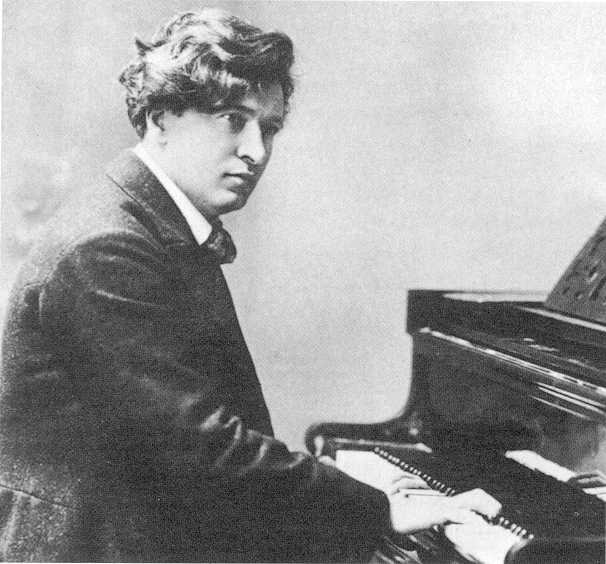 [ Left
photo ] Busoni(Photo from Hyperion CDA 66566)
[ Left
photo ] Busoni(Photo from Hyperion CDA 66566)
Ferruccio Dante
Michelangiolo Benvenuto Busoni(1866~1924) was famous
pianist and composer in his comtemporary. He published
Bach's works by his transcription at Breitkopf und
Härtel from 1888(at 22 years old) to 1920 for more
than 30 years, which was task of his total life.
He transcribed Bach's spirit to piano.
If we judge him now, it's obvious that he reflected the
romantic years when he had lived. But pianists have to
watch how he traslated idioms of cembalo, organ, and even
violin to piano. I think his translation of
Chaconne(BWV.1004-5) and organ works have to be
noticable. The former explicited Bach's various
polyphonic lines, so Hugo Leichtentritt(famous
musicologist and his first biographer) even said
"It's easier to analyse this work with Busoni's
transcription". And the latter used pedal very
audaciously and delicately, which are indispensable to
playing organ works by piano. Busoni said ;
...not believe in the legendary tradition, that Bach must be played without the pedal. While the pedal is sometimes necessary in Bach's piano works, it is absolutely essential in transcribed organ pieces... Consider, that the mixtures opened with the full organ contain the 5th and octave, or even the 3rd and 7th, of every tone struck. An approximate imitation of these tone-blendings can be obtained, on the piano, only by using the pedal. [In an appendix to Volume I of his performing edition of the Well-Tempered Clavier, 'On the Transcription of Bach's Organ Works for Pianoforte'(New York, Jan. 1894, G.Schirmer edition)]
2. Busoni's pedaling in organ transciptions
Busoni used
piano's all three pedals freely in this transcriptions.
He said "Real organ-effects can be 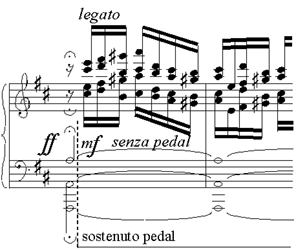 obtained only
by the combined action of the three pedals."
obtained only
by the combined action of the three pedals."
In the organ
pedal notes, he uses the sostenuto pedal(middle pedal of
Grand piano) of Steinway. Left score is from Prelude
and Fugue in D major BWV.532, in which he shows how
to use the sostenuto pedal for imitation of organ's foot
keyboard. Of course, this pedal is most suitable to this
purpose without overblurring high register. But he played
his works at the pianos with only two pedals(without
middle pedal. Some European piano makers produce models
not having this pedal by Steinway-patented
technology. For example, Bösendorfer produces
both the two types from now on), in which case he used
damper pedal instead of middle pedal.
In his opinion, left(shifting) pedal is
not only for small sound volume but for different tone
quality. So it is proper to express to the change of
organ stops.
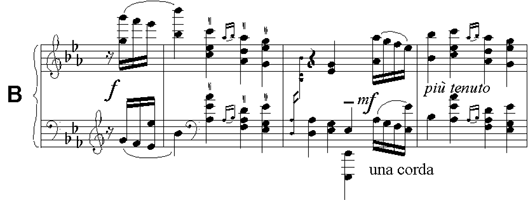
In
special, 'echo effect' is most effective to use this
pedal. We can find the example in his transcription of
'St.Anne', BWV.552(score above).
Busoni did not indicate directly to use
all the pedals at one time, but these method can perhaps
be used. (The method using middle and left pedal by left
foot is precisely recommended by Percy Grainger)
His transcription of organ works are '~ and fugues' (BWV.532,564,565,552) and chorale preludes(BWV.639,659, etc.), all of which are good and often played in concert with his marvellous Chaconne.
References ;
- Joseph Banowetz, The pianist's guide to pedaling, Indiana University Publishing, 1985
- Ates Orga and Nikolai Demidenko, Liner Note of Hyperion CDA 66566, 1992
3. Recommended Disques
Though pianaists play pretty often, there are only a bit CDs that totally comprised of Busoni's transcriptions. In 2000, Kun-Woo Paik's album(Decca) is released, which includes BWV.564, Chaconne, and 10 Choral preludes.
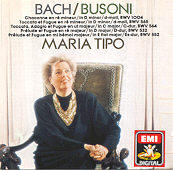 |
1. Maria
Tipo(EMI CDC 7 49066 2)
This
CD includes most of frequently played works and
chaconne, so I think it best in coupling, though
Choral Preludes were not included because of CD
time limit. But the tempo, is too slow on the
whole, and magnificence of organ taste is
insufficient. So, I'd not like to recommend this.
|
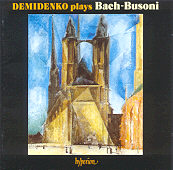 |
2. Nikolai
Demidenko(Hyperion CDA 66566)
This CD does not include Chaconne and BWV.532, but Capriccio and famous 3 Chorale preludes. Its liner note is very good as is an usual case of Hyperion's CD. Demidenko's style is grandeur taste, but too romantic and arbitrary, I think. Of course the works are transcriptions from original, but I can't help considering added cadenza to the end of Prelude of BWV.552 as too much 'overaction'. ^^ |
I'd rather recommend the nexts by piano maestros than the formers. Some notable records ;
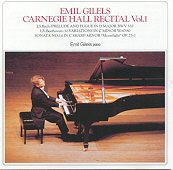 |
1) Prelude
and Fugue in D major, BWV.532
Released as 'Carnegie Hall Recital', this CD shows Gilels' perfectness in recital well. BWV.532 has both delicacy and power, and his very beautiful tone color and astonishing power of ff reveal charm of Busoni's transcription on a large scale. Beethoven's Moonlight and Variation WoO.80 show his powerful and stable interpretation with a large scale, too. |
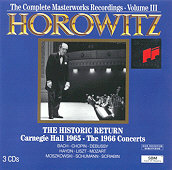 |
2) Toccata,
Adagio and Fugue in C major, BWV.564
This
recording is really deserved to to the word
'Historical return', and I think this is one of
the best piano recital. The first program was
BWV.564. He made a very big mistake at the
beginning due to very large strain, but after a
while he was completely 'Perfect Pianist
Horowitz'. His colorful tone made this work alive
and cleared the texture of organ. Other programs
- Schumann's Fantasy in C major, Chopin, Scriabin
- are very beautiful. Coupled recording is live
in 1966 at the same hall, which are also good.
Very strongly recommended. |
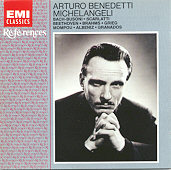 |
3) Chaconne
in d minor, BWV.1004-5
Michelangeli
recorded this album in his 19~28 old years at
Italy and Abbey Road. First is Chaconne, which
gives me very intense impression by perfect
technique and firm constuction of musical span.
Sound quality is less than normal 78's transfer,
but large scale and magnificent style make us
know that he was already a completed virtuoso.
Later live recording in 1973(Music and Arts) is
surely inferior to this in impression. |
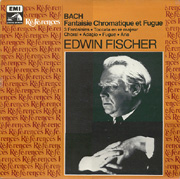 4) Chromatic Fantasy and Fugue in d minor
BWV.903, etc.
4) Chromatic Fantasy and Fugue in d minor
BWV.903, etc.
* Edwin Fischer(EMI Références LP 2912221)
* Recordings ; 1931~49, Berlin & Abbey Road Studios
Not to know the reason, this precious recordings are reissued only fragmentarily. This LP comprises of next works ;
- Chromatic fantasy and fugue in d minor, BWV.903 (1931)
- Fantasy and fugue in a minor, BWV.904 (1937)
- Fantasies ; c minor BWV.906 (1949), a minor BWV.922 (1937)
- Toccata in D major, BWV.912 (1941)
- Chorale Prelude 'Ich ruf zu dir' BWV.639 (1941)
- Adagio(arrgt. E.Fischer from Concerto BWV.974 after Marcello)(1933)
- For String Orchestra ;
Fugue in a minor BWV.865(arrgt. E.Fischer, from Well-Tempered Clavier Book I) (1939)
Air(from Ouverture No.3 BWV.1068) (1939)
BWV.903,904, and 906 were released in CDH 7 64928 2, but now deleted from catalog. BWV.639,903,904 and 922 are in 'Edwin Fischer Vol.I' of Philips Pianist Series, and Pearl's issues are coupled by Well-Tempered Clavier. BWV.903 and 912 have very intense power, and tone quality of BWV.639 is really as beautiful as that of a bell. Fischer recorded BWV.552 also, but it is not yet in EMI issue(Pearl GEMM 9481 and 0017 contains this).
5) Chorale Preludes ; BWV.639,659, etc.
BWV.639 and 659 are perhaps most frequently recorded in Busoni's transcription. At first, I recommend Lipatti's reissue item including famous 'Siciliano'(EMI CDM 5 67003 2) and Brendel's recording in 1976(Philips 412 252-2, including BWV.903, Italian Concerto, and BWV.922 etc. Brendel re-recorded BWV.639 and 659 in digital era). For only BWV.639, Fischer's is the best in Philips Pianist Series. Horowitz's BWV.639(Sony SK 48903) is very good, also.
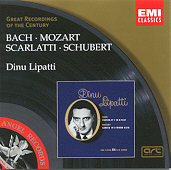
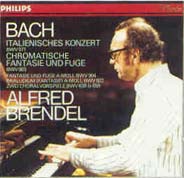
ps. Many Bach-transcription records are sold except Busoni's. I want to recommend Kempff's recording including Siciliano(DG 439 108-2 and Double series) and Nikolaeva's(Melodiya).
Links
- Ferruccio Busoni's home(Japanese) ; Very good, but Japanese - however, discography of Busoni's works is in English, which includes the recordings of his Bach transcriptions.
(c) 2000~, Youngrok LEE ; Link free, but please get my approval before you reuse, copy, or quote this materials.
Created ; 28th Feb. 2000
(original
Korean text created on 4th Jan. 2000)
Last Update ;
26th Sep. 2008